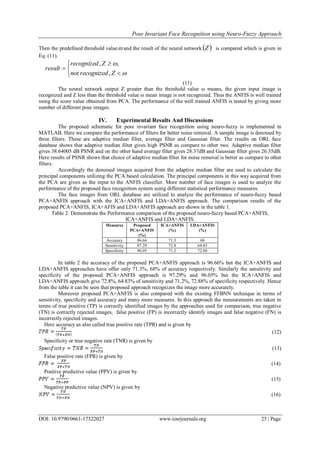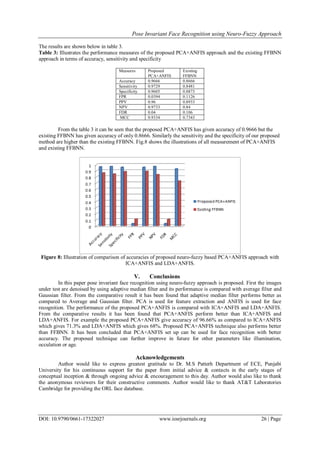The document describes a proposed approach for pose invariant face recognition using a neuro-fuzzy system. The approach uses adaptive median filtering to remove noise from face images. Principal component analysis (PCA) is then used to extract features from the preprocessed images. The PCA features are classified using an adaptive neuro fuzzy interface system (ANFIS) classifier. The ANFIS classifier uses a five layer architecture for classification. The proposed PCA+ANFIS approach is evaluated on the ORL face database and is shown to outperform LDA+ANFIS, ICA+ANFIS, and feedforward neural network approaches in terms of accuracy, sensitivity and specificity for pose invariant face recognition.
![IOSR Journal of Computer Engineering (IOSR-JCE)
e-ISSN: 2278-0661,p-ISSN: 2278-8727, Volume 17, Issue 3, Ver. II (May – Jun. 2015), PP 20-27
www.iosrjournals.org
DOI: 10.9790/0661-17322027 www.iosrjournals.org 20 | Page
Pose Invariant Face Recognition using Neuro-Fuzzy Approach
Reecha Sharma1
, M.S Patterh1
1
Department of ECE Punjabi University Patiala, Punjab, India
Abstract : In this paper a pose invariant face recognition using neuro-fuzzy approach is proposed. Here
adaptive neuro fuzzy interface system (ANFIS) classifier is used as neuro-fuzzy approach for pose invariant face
recognition. In the proposed approach the preprocessing of image is done by using adaptive median filter. It
removes the salt pepper noise from the original images. From these denoised images features are extracted.
Here Principal component analysis (PCA) is used for extracting the features of an image under test. Then
ANFIS classifier is used for face recognition. PCA calculate the principal components and are used by ANFIS
for further process. Here in this paper combination of PCA and ANFIS is represented as PCA+ANFIS. In the
paper standard ORL face database is used for experimental results. The performance PCA+ANFIS with
LDA+ANFIS and ICA+ANFIS is analyzed and compared. From experimental results it is shown that
PCA+ANFIS outperforms than other two approaches. PCA+ANFIS is also compared by existing feed forward
neural network (FFBNN) approach. The results show that proposed approach gives better outputs in terms of
accuracy, sensitivity and specificity.
Keywords - Feature extraction, image denoising, image recognition, neural networks and feedforward neural
network.
I. Introduction
These days security is one of the most common and important issue. Passwords are easily hacked by
hackers. So for more security unique passwords or something which only users have for authentication are
necessary. Human traits are unique and more secure for identification. These days human authentication is done
by biometrics. Many biometric traits are used for this purpose. One of the most common reasons of using
biometric traits is that they are unique and can’t be stolen, share or reproduced. Most commonly used traits are
palm, iris, finger prints, voice and face. All traits except face need presence of an individual for authentication.
But in case for face trait images of a person can be use for this purpose. Human can easily recognize faces but
by computer vision machines and pattern recognition it is challenging task. Face recognition can hurriedly and
correctly recognize target persons when the conditions are favorable. Researchers find many challenges in face
recognition. The most common challenges are pose, illumination, occulation, expression etc. In this proposed
research paper a pose invariant system for face recognition has been studied.
The rest of paper is organized as follows: Section II explains a brief knowledge about related work.
Section III explains schematic of proposed neuro-fuzzy approach for pose invariant face recognition. Section IV
gives experimental results and discussion and in section V conclusion and future scope of proposed work
explained.
II. Related Work
There are two main broad categories of face recognition. They are template based or feature based. In
first category i.e. template based full face is considered for recognition purpose. In second category i.e. feature
based only common features are used. These features may be eyes, nose, mouth and ear etc. combination of
feature is also used for improving the recognition rate [1]. The eigenfaces or Principle Components are the set of
characteristic features of a face obtained by decomposing a face. Eigenface gives training phase. For recognition
test image is placed into subspace called face space and recognition is done by comparing the test image with
trained database in face space [2]. Neural network architecture is used for pose invariant face recognition. PCA
is used for feature extraction and neural network is used for recognition [3]. It seems to be very difficult for
human to recognize faces correctly when the illumination varies severely, since the same person appears to be
very much different. Back propagation neural network is used for illumination invariant face recognition. The
features of an image are extracted in eigenspace. Then illumination direction specific back propagation neural
network trains the extracted feature and then testing is down [4]. Radial basis function (RBF) neural classifier
reduces the problem of small training set of high dimensional [5]. Non linear face images give 90% of
acceptance ratio when back propagation neural network is combined with PCA [6]. Combination of SOM and
convolution network gives fast and automatic system for face recognition as compare to Eigen faces [7]. When
PCA combined with feed forward neural network PCA-NN gives improved recognition as compare to
traditional PCA. The same improvement is shown in LDA-NN [8]. FFNN improves the performance of face](https://image.slidesharecdn.com/d017322027-160701041435/85/D017322027-1-320.jpg)
![Pose Invariant Face Recognition using Neuro-Fuzzy Approach
DOI: 10.9790/0661-17322027 www.iosrjournals.org 21 | Page
recognition as compare to Euclidean distance [9]. The novel architecture of the two-layer neural can recognize
human face with different views. It recognizes the identity of the person and the pose variation of a face at the
same time [10]. A combination of RBFNN and FHLA is used for face recognition. It provides faster training
with less number of neurons in hidden layer [11]. ANFIS and SVM fuse local and global features for face
verification. They fused together for better face recognition as compare to non adaptive and non fusion schemes
[12]. Linear Discriminant Analysis (LDA) is just like as eigenfaces of PCA. The only difference of LDA and
PCA is in the method of calculating the subspace. LDA maximize the ratio of the between class scatter matrix
and within class scatter matrix [13]. One hidden layer FFNN not only reduces the hidden units but also weights.
It gives better results as compare to BPNN [14]. Fusion of LDA and PCA give better results in face recognition
because they are intercorrelated to each other [15]. Independent component analysis (ICA) is a generality of
PCA. It separates the high order and second order moments. ICA is performed on images of face database by an
unsupervised learning algorithm derived from the optimal information transfer through sigmoidal neurons [16].
ICA, PCA and rough set theory combined to make a hybrid method for face recognition. ICA and PCA are used
for feature extraction and for recognition rough set rule based classifiers are used [17]. In this proposed paper
we are comparing PCA+ANFIS with LDA+ANFIS, ICA+ANFIS and also with FFBNN.
III. Schematic For Neuro-Fuzzy Approach
The proposed schematic for pose invariant face recognition using neuro-fuzzy approach is discussed in
this section. Here in the proposed approach PCA+ANFIS based pose invariant face recognition is done.
Proposed schematic for pose invariant face recognition using neuro-fuzzy approach have following steps.
1. The original images are taken from some standard face database. In our proposed schematic ORL face
database is used. The ORL face database images are grouped as test images and training images.
2. These images are preprocessed. Here hybrid filter called adaptive median filter is used for removing salt
and pepper noise from the original images.
3. These denoised images are given to PCA for feature extraction. Here principal components are calculated
and saved for further use.
4. These principal components are used by ANFIS a neuro-fuzzy classifier. The proposed ANFIS have five
layers. This is used for classification of images.
5. Here classified images are compared with predefined threshold value. If it greater than threshold value then
it is a recognized face otherwise not.
These steps are explained in detail in further sub sections.
3.1 Adaptive median filter
The adaptive median filter is used for preprocessor for noise removal. The noised images ),( srfd from ORL
face database are given as input to the adaptive median filter. These images are affected by the impulse and salt-
pepper noise. The output of adaptive median filter is noise free image. Fig.1 shows some samples of the noised
images from ORL face database. Fig.2 shows noise free output of adaptive median filter.
Figure 1: Sample of noised images from the ORL face database.
Figure 2: Denoised images after adaptive median filtering.](https://image.slidesharecdn.com/d017322027-160701041435/85/D017322027-2-320.jpg)





![Pose Invariant Face Recognition using Neuro-Fuzzy Approach
DOI: 10.9790/0661-17322027 www.iosrjournals.org 27 | Page
References
[1]. Brunelli Roberto And Tomaso Poggio, "Face Recognition: Features Versus Templates," IEEE Transactions On Pattern Analysis
And Machine Intelligence, Vol. 15, No. 10, Pp. 1042-1052, 1993.
[2]. Turk Matthew And Alex Pentland, "Eigenface For Recognition," Journal Of Cognitive Neuroscience, Vol. 3, No. 1, Pp. 71-86,
1991.
[3]. Huang, Fu Jie, Zhihua Zhou, Hong-Jiang Zhang, And Tsuhan Chen, "Pose Invariant Face Recognition," In Fourth IEEE
International Conference On Automatic Face And Gesture Recognition, 2000, Pp. 245-250.
[4]. Wu-Jun Li, Chong-Jun Wan, Dian-Xiang Xu, And Shi-Fu Chen, "Illumination Invariant Face Recognition Based On Neural
Network Ensemble," In Proceedings Of The 16th IEEE International Conference On Tools With Artificial Intelligence (ICTAI
2004), 2004.
[5]. Ermeng Joo, Wu Shiqian, Lu Juwei, And Toh Hock Lye, "Face Recognition With Radial Basis Function (RBF) Neural Networks,"
Neural Networks, IEEE Transactions On, Vol. 13, No. 3, Pp. 697-710, 2002.
[6]. Mohammod Abul Kashem, Md. Nasim Akhter, Shamim Ahmed, And Md. Mahbub Alam, "Face Recognition System Based On
Principal Component Analysis (PCA) And Back Propagation Neural Network (BPNN) ," International Journal Of Scientific &
Engineering Research Volume 2, Issue 6, June-2011, Vol. 2, No. 6, Pp. 1-10, June 2011.
[7]. Lawrence Steve, Giles C Lee, Tsoi Ah Chung, And Back Andrew D, "Face Recognition: A Convolutional Neural-Network
Approach," Neural Networks, IEEE Transactions On, Vol. 8, No. 1, Pp. 98-113, 1997.
[8]. Alaa Eleyan And Hasan Demirel, "PCA And LDA Based Face Recognition Using Feedforward Neural Network Classifier,"
Multimedia Content Representation, Classification And Security, Pp. 199-206, 2006.
[9]. Alaa And Demirel, Hasan Eleyan, "Face Recognition System Based On PCA And Feedforward Neural Networks," In
Computational Intelligence And Bioinspired Systems, Pp. 935--942, 2005.
[10]. Huang Fu Jie, Zhihua Zhou, Hong-Jiang Zhang, And Tsuhan Chen, "Pose Invariant Face Recognition," In In Automatic Face And
Gesture Recognition, 2000. Proceedings. Fourth IEEE International Conference On, 2000, Pp. 245-250.
[11]. Haddadnia Javad, Faez Karim, And Ahmadi Majid, "A Fuzzy Hybrid Learning Algorithm For Radial Basis Function Neural
Network With Application In Human Face Recognition," Pattern Recognition, Vol. 36, No. 5, Pp. 1187-1202, 2003.
[12]. Fang, Yachun, Tieniu Tan, And Yunhong Wang, "Fusion Of Global And Local Features For Face Verification," In Pattern
Recognition, 2002. Proceedings. 16th International Conference On, Vol. 2, 2002, Pp. 382--385.
[13]. Eleyan Alaa And Demirel Hasan, Pca And LDA Based Neural Networks For Human Face Recognition.: INTECH Open Access
Publisher, 2007.
[14]. Ma Liying And Khorasani Khashayar, "Facial Expression Recognition Using Constructive Feedforward Neural Networks,"
Systems, Man, And Cybernetics, Part B: Cybernetics, IEEE Transactions On, Vol. 34, No. 3, Pp. 1588--1595, 2004.
[15]. Marcialis Gian Luca And Fabio Roli, "Fusion Of LDA And PCA For Face Verification," In Biometric Authentication, Pp. 30-37,
2002.
[16]. Bartlett Marian Stewart, "Independent Component Representations For Face Recognition," In Face Image Analysis By
Unsupervised Learning Springer US, Pp. 39-67, 2001.
[17]. Swiniarski, Roman W, And Andrzej Skowron, "Independent Component Analysis, Principal Component Analysis And Rough Sets
In Face Recognition," Transactions On Rough Sets I. Springer Berlin Heidelberg, Pp. 392-404, 2004.](https://image.slidesharecdn.com/d017322027-160701041435/85/D017322027-8-320.jpg)